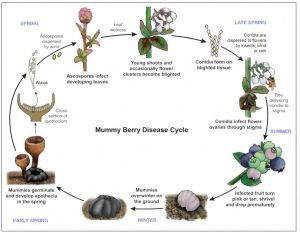Post-Harvest Disease Management for the 2017 Blueberry Season
Renée Holland and Dr. Phil Brannen
Growers have been asking questions regarding what to do about unharvested fruit in the fields and the potential for disease impact on the blueberry crop next year.
Concerning mummy berry disease, unharvested fruit will not impact this disease in the next crop season. Infection occurs in the spring, and that is the only timeframe (green tip and bloom) when fungicides can be applied to target this disease. Infected fruit from this past spring, those that are mummified, will serve as the inoculum source for this disease next year, but these fruit have likely already fallen to the ground by now anyway. Cultural management practices are certainly encouraged for this disease, if feasible. Noticeably, many growers work towards cleaning up fields post-harvest by hoeing out weeds and raking dead leaf, stem, and fruit matter into the row middles after hedging and pruning. Flail-mowing this material is a good practice, and harrowing the material to bury mummies in the ground or even throwing soil back onto the beds can potentially help to bury mummies. However, root systems of blueberries should not be injured by implements or covered with substantial amounts of soil through these practices; damaged roots can serve as infection points for Phytopthora and other pathogens, and “dirting” blueberries will reduce oxygen levels to the roots, resulting in low oxygen levels in the root system (poor growth, rot and death). Mummy berry disease can be reduced by burying mummies one inch or deeper in the row middles; however, it is unlikely that all mummies are buried sufficiently, so fungicides are always recommended as leaves and blossoms emerge in the spring.
Diagram credit: Schilder et al. MSU; Illustration by Marlene Cameron (click photo to enlarge)
Good sanitization practices can reduce the survival of many fungal disease-producing organisms in the field. Unharvested berries will eventually fall off the plant, and anything that will hasten decomposition of these fruit is encouraged. Flail-mowing of decomposing plant material (e.g. hedged stems and twigs) helps to destroy survival structures of fungal pathogens that affect blueberry, such as those of Botryosphaeria stem blight. Flail mowing removes bark and breaks up the woody tissues, drying up fungal survival structures and encouraging entry of natural soil-borne competitors and biocontrol agents into proximity of pathogens such as Botryosphaeria. We don’t have a good research base in blueberries to support flail-mowing, but research in apples and peaches have shown that this operation, chopping wood tissues into smaller pieces and shredding bark, expedites decomposition by saprophytic organisms while lessening the opportunity for future pathogen colonization in the following year. Application of urea is also recommended in apples to increase the decomposition rate for flail-mowed prunings and leaves, so a banded application of urea to the flail-mowed tissue in the blueberry row middles may further the decomposition process.
Also, don’t forget to focus on rust and leaf spot management as the summer progresses. Recommendations can be found in the 2017 Blueberry Integrated Pest Management Guide at smallfruits.org. As always, plant health is the first defense against disease and should be monitored closely.
References
2005. Botryosphaeria canker and white rot of apples. Report on Plant Disease University of Illinois Extension: RPD No. 813.
Layne, D. R. 2010. Now’s Your Chance! The American Fruit Grower: 52-53. (https://www.clemson.edu/extension/peach/commercial/pests/now-is-your-chance.html)
Schilder, A., Wharton, P., and Miles, T. 2008. Michigan Blueberry Facts: Mummy Berry. Extension Bulletin E-2846.
Starkey, T. E., and F. F. Hendrix, Jr. 1980. Reduction of substrate colonization by Botryosphaeria obtusa. Plant Disease 64: 292-294.
